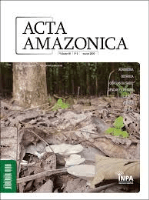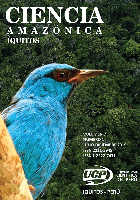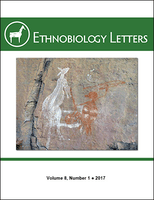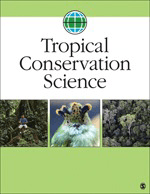
Ethnobiology and Conservation
Scope & Guideline
Connecting Traditional Knowledge with Scientific Inquiry
Introduction
Aims and Scopes
- Ethnobiological Practices:
The journal emphasizes research on traditional knowledge related to the use of plants and animals, highlighting how these practices are intertwined with local cultures and biodiversity. - Conservation Strategies:
It explores effective conservation strategies that incorporate traditional ecological knowledge, assessing their impact on biodiversity and ecosystem management. - Human-Wildlife Interactions:
Research on the dynamics of human-wildlife relationships is central, investigating how cultural beliefs and practices affect wildlife conservation and management. - Ethnoecology and Local Knowledge:
The journal promotes studies that delve into local ecological knowledge, examining how indigenous and local communities understand and interact with their environments. - Policy and Governance:
It addresses the implications of traditional ecological knowledge on conservation policies and governance, advocating for inclusive approaches that consider local perspectives.
Trending and Emerging
- Climate Change Impacts:
There is an increasing focus on the effects of climate change on local ecological knowledge and biodiversity, highlighting the urgent need to understand these dynamics in conservation efforts. - Urban Ecology and Biodiversity:
Emerging studies address the interactions between urban environments and biodiversity, exploring how urbanization affects local ecological knowledge and conservation practices. - Political Ecology and Ethnobiology:
Themes exploring the political dimensions of ethnobiology, including governance and policy implications, are gaining prominence, reflecting a growing interest in the socio-political context of conservation. - Food Security and Biodiversity:
The intersection of food security and biodiversity conservation is increasingly addressed, emphasizing the role of ethnobiological knowledge in sustainable food practices. - Community-Based Conservation:
There is a notable trend towards research on community-driven conservation initiatives, emphasizing participatory approaches that engage local communities in biodiversity management.
Declining or Waning
- Traditional Medicinal Practices:
While still relevant, the frequency of studies specifically focused on traditional medicinal practices has decreased, possibly reflecting a broader interest in integrating these practices with modern health approaches. - Historical Ethnobiology:
Research centered on historical perspectives of ethnobiology appears to be waning, indicating a potential shift towards contemporary issues and applications rather than historical documentation. - Species-Specific Studies:
There seems to be a reduction in articles focusing narrowly on specific species, suggesting a move towards broader ecological and socio-cultural contexts rather than isolated studies.
Similar Journals

ACTA AMAZONICA
Advancing Knowledge for a Sustainable Amazon.ACTA AMAZONICA, an esteemed journal published by the Instituto Nacional de Pesquisas da Amazônia, is a pivotal resource in the fields of Agricultural and Biological Sciences, reflecting its stature with a 2023 Q2 category ranking. Since its inception in 1979 and transitioning to Open Access in 2003, this journal has dedicated itself to disseminating significant research related to the Amazon region, contributing to the understanding of its biodiversity, ecology, and sustainability challenges. With an ISSN of 0044-5967 and E-ISSN 1809-4392, ACTA AMAZONICA provides a platform for researchers, professionals, and students to share innovative findings and insights. Based in Manaus, Brazil, it plays a critical role in fostering collaborative research efforts that address environmental and conservation issues pertinent to the Amazonian context. Its commitment to accessibility ensures that valuable research is available to a wide audience, fulfilling its objective of promoting knowledge and encouraging dialogue amongst the global scientific community.

AMBIO
Exploring innovative solutions to contemporary environmental challenges.AMBIO, published by Springer, is a prestigious journal that has been at the forefront of environmental research since its inception in 1973. With an ISSN of 0044-7447 and an E-ISSN of 1654-7209, this journal provides a vital platform for the dissemination of interdisciplinary studies that intersect ecology, environmental chemistry, geography, and medicine. Based in the Netherlands, AMBIO holds a remarkable position in the academic world, ranked Q1 in multiple categories, including Ecology and Environmental Chemistry, reflecting its commitment to high-quality scholarly work. Researchers looking to contribute to or stay abreast of significant advancements in understanding and addressing contemporary environmental challenges will find AMBIO to be an essential resource, catering to the needs of a diverse audience comprising scholars, practitioners, and policymakers. While the journal is not open access, its wide-ranging influence in the social sciences, particularly regarding geography and development, alongside its high impact factor, underscores its importance for the future of environmental research.

JOURNAL OF WILDLIFE MANAGEMENT
Exploring the intersection of ecology and conservation.Welcome to the Journal of Wildlife Management, a premier publication dedicated to advancing the science and practice of wildlife management. Published by Wiley, this journal spans decades of impactful research and has been a cornerstone in the fields of Ecology, Evolution, Behavior, and Nature and Landscape Conservation. With an impressive ranking in the Q1 quartile across multiple disciplines, it provides a crucial platform for interdisciplinary collaboration and dissemination of knowledge among researchers, practitioners, and policy-makers. Covering a wide range of topics pertinent to wildlife management, this journal promotes innovative techniques and sustainable practices that are essential in addressing contemporary ecological challenges. The Journal of Wildlife Management is rigorously peer-reviewed, ensuring high standards of quality and relevance, making it an invaluable resource for those committed to conservation and ecological research.

Ciencia Amazonica
Exploring the Heart of the Amazon: Research, Conservation, and CultureCiencia Amazonica is a prominent academic journal dedicated to the exploration and dissemination of research pertaining to the Amazon region, reflecting the rich biodiversity, cultural heritage, and environmental challenges that characterize this unique ecosystem. Published by UNIV CIENTIFICA PERU, this journal has embraced an Open Access model since 2011, ensuring that valuable scientific findings are freely accessible to researchers, professionals, and students worldwide. With its commitment to fostering collaborative research and dialogue, Ciencia Amazonica serves as an essential platform for sharing innovative studies, fostering conservation efforts, and promoting sustainable development practices within the Amazon Basin. As the journal continuously seeks to engage with critical issues faced by this vital region, it is a crucial resource for anyone interested in the complex interplay of ecology, social sciences, and environmental policy in the Amazon.

ECONOMIC BOTANY
Innovating the Understanding of Plant Utilization in EconomicsEconomic Botany, published by Springer, is a prestigious academic journal that has been at the forefront of research in the intersection of botany and economics since its inception in 1947. With an E-ISSN of 1874-9364 and a traditional ISSN of 0013-0001, this journal serves as a crucial platform for disseminating knowledge on the utilization and cultivation of plants that hold economic significance. While it does not operate under an Open Access model, the journal benefits from being indexed in high-quality databases, boasting a strong standing in 2023 with a Q2 classification in both Horticulture and Plant Science categories. Economic Botany enjoys an impressive Scopus ranking, positioned 24th out of 115 in Horticulture and 159th out of 516 in Plant Science, reflecting its influence and contribution to the field. Researchers, professionals, and students will find this journal essential for accessing cutting-edge studies that explore the vital role of plants in economies worldwide, fostering an interdisciplinary dialogue that shapes future botanical research and applied practices.

Ethnobiology Letters
Bridging Cultures and Ecosystems for a Sustainable FutureEthnobiology Letters is a pioneering journal in the field of ethnobiology, dedicated to the scientific study and documentation of the intricate relationships between human cultures and biological diversity. Published by the Société d'Éthnobiologie, this open-access journal has been providing an invaluable platform for researchers and scholars since its inception in 2010. Operating under the ISSN 2159-8126, it aims to promote accessibility and dissemination of knowledge across global communities by making its content freely available. Its contributions have garnered recognition in the realms of anthropology and agricultural sciences, achieving notable ranks in Scopus with a percentile standing in the 56th for Social Sciences and 41st for Agricultural and Biological Sciences. By fostering interdisciplinary dialogue and sharing innovative research, Ethnobiology Letters serves as a crucial resource for academics, practitioners, and students engaged in the exploration of the cultural dimensions of biodiversity.

ACTA SOCIETATIS BOTANICORUM POLONIAE
Pioneering Discoveries in Plant Science and EcologyACTA SOCIETATIS BOTANICORUM POLONIAE is a reputable open-access journal dedicated to the field of Plant Science, published by the Polskie Towarzystwo Botaniczne since 1923. With an ISSN of 0001-6977 and an E-ISSN of 2083-9480, this journal has made significant contributions to the botanical sciences, fostering the dissemination of research from Poland and beyond. The journal has ranked in the third quartile (Q3) within its category in the 2023 journal metrics, demonstrating a strong presence in the global academic community, as evidenced by its Scopus ranking of 291/516 within the Agricultural and Biological Sciences sector, placing it in the 43rd percentile. While specific H-Index data are currently not available, ACTA continues to attract submissions from a broad international audience and publishes a wide range of studies that advance the understanding of plant biology, ecology, and conservation. The journal remains a vital resource for researchers, professionals, and students alike, committed to enhancing knowledge and collaboration in botanical science.

Global Ecology and Conservation
Empowering conservation through open-access research.Global Ecology and Conservation, published by Elsevier, stands as a premier open-access journal dedicated to advancing the field of ecology and conservation science. Since its inception in 2014, the journal has facilitated the dissemination of high-quality research, fostering critical dialogue on ecosystem management, biodiversity preservation, and sustainability practices across the globe. With a remarkable ranking within the top quartiles (Q1) in various categories including Ecology, Evolution, Behavior and Systematics, and Nature and Landscape Conservation, it is positioned among the leading resources for researchers and professionals alike. The journal has garnered a notable impact, ranking #65 out of 721 in Ecology, and houses articles that are vital to understanding and addressing the pressing environmental challenges of our time. Available in an open-access format, researchers can freely access and share vital findings, promoting a collaborative approach to ecological research. Global Ecology and Conservation is not just a publication; it is a critical tool for innovation and advocacy in conservation, poised to inspire the next generation of environmental stewards.

Journal of Ethnobiology and Ethnomedicine
Unveiling the Wisdom of Nature through Cultural InsightsJournal of Ethnobiology and Ethnomedicine, published by BMC in the United Kingdom, is a premier open-access journal that has been at the forefront of interdisciplinary scholarship since its inception in 2005. With its focus on the intricate relationships between humans and their biological environments, the journal serves as a vital resource for researchers, professionals, and students alike. It boasts a remarkable impact, reflected in its status as a Q1 journal in prominent categories such as Agricultural and Biological Sciences, Complementary and Alternative Medicine, and Cultural Studies. The journal is indexed in Scopus, where it ranks impressively high, including a top 1% position in Cultural Studies and a notable 90th percentile ranking in Complementary and Alternative Medicine. By providing open access to insightful articles that bridge empirical research and cultural knowledge, the Journal of Ethnobiology and Ethnomedicine plays a crucial role in advancing the discourse surrounding traditional practices and their implications for health and sustainability. Join us in exploring this fascinating domain where science meets cultural wisdom.

Tropical Conservation Science
Driving impactful research for environmental resilience.Tropical Conservation Science, an esteemed journal published by SAGE Publications Inc, plays a pivotal role in the field of environmental science, particularly within the realms of ecology and nature conservation. Established as an Open Access platform since 2008, it facilitates global dissemination of critical research findings dedicated to the preservation of tropical ecosystems. With an impressive impact factor reflected in its Q2 rankings within both ecology and nature landscape conservation categories for 2023, the journal is ranked in the 66th percentile for Environmental Science and maintains a strong position in the academic community. The journal’s scope encompasses a wide array of tropical conservation issues and aims to foster interdisciplinary collaboration among researchers, professionals, and students committed to advancing conservation strategies. Tropical Conservation Science is not merely a publication; it's a vital resource contributing to the safeguarding of our planet's biodiversity.